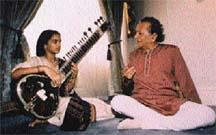
Famed artist Ravi Shankar and daughter Anoushka deligt in midwest sounds of the east. Shankar helped popularize Indian music in the US.
Known as a composer, teacher, writer, and perhaps most of all as a virtuoso sitarist, Ravi Shankar still performs with incredible vitality and taste.Shankar’s is a name that everyone should at least recognize. A career that has spanned over 60 years has ventured throughout the traditional Indian classical music realm and into popular and jazz music. Musicians such as George Harrison of the Beatles, John McLaughlin, and Philip Glass have all been influenced enormously by him.
Touring with him is his daughter, Anoushka Shankar, also on the sitar, and already highly regarded as a unique artist in her own right at the age of 21. Trained completely by her father, she made her debut at age 13 in New Delhi, India, assisting her father.
Ravi and Anoushka were accompanied in their PAC performance by two tabla players, Tanmoy Bose and Arup Chattopadhyay, and two assistants on tanpuras.
It was announced before the concert that Anoushka was suffering from a hand injury, and so would not open the concert for her father as was planned. Fortunately, she was still going to play for the whole show and assist her father.
The musicians came out on stage and Ravi announced the first piece. It was a long piece, divided into two parts. The first part was a beautiful and slow duet played between Ravi and Anoushka with the tanpuras droning in the background.
Arup crept in on tabla for the second part of the piece and settled on a seven-beat cycle. The tempo picked up more and more toward the end and the piece grew in intensity as Ravi and Anoushka exchanged cycles with each other.
For the second piece, Tanmoy Bose replaced Arup on the tabla. Ravi introduced the piece as a 16-beat cycle (divided into four groups of four) for the first half, followed by a 12-beat cycle.
The piece started slow, showing just how deliberate and in control Ravi and Anoushka are in creating flowing melodies around the cycle.
A transition led into the second half of the piece and the tempo picked up a lot and kept getting faster. Just when you thought that it had reached its peak they would speed up a little bit more.
It was especially impressive when Tanmoy would break into a double time and really push the limit on how fast and intensely the group could play.
After the intermission, Ravi announced the final piece of the night. The two tabla players alternated with one another over a 12-beat rhythmic cycle. They moved from this to many different rhythmic cycles, throwing the listener off guard with each new rhythm just when the listener was becoming comfortable with the last one. They eventually settled into a faster 16-beat rhythmic cycle for the tabla solos.
Tanmoy’s solo was especially impressive as he built from a simpler groove he was playing to more complex ideas. Anoushka held down a very simple ostinado, similar to a walking bass line in jazz, for him to solo over. You could plainly see from Ravi and Anoushka’s eyes that they loved what Tanmoy was doing.
After the tabla solos Ravi and Anoushka exchanged cycles with each other in a call and response manner. As their improvising became more exciting, Ravi would play with the tabla players’ minds by starting his cycles a little early or late, trying to catch the accompanying tabla player off guard. Each time one of them was not phased, Ravi would give him a smile, and he would know that Ravi was pleased.
This was an event that anyone who witnessed will probably remember forever. Ravi holds a place in music on a level with the greatest geniuses of all time. It is extremely fortunate for the Appleton area that the Performing Arts Center was able to bring in someone so legendary.
